Unveiling the Untapped Potential of Fixed Wireless Access
In an age where high-speed internet is as essential as electricity, Fixed Wireless Access (FWA) is emerging as a revolutionary technology offering new possibilities for connectivity. This article explores the nuances of FWA, its impact on the telecom industry, and its role in shaping the future of digital communication.

The Genesis and Evolution of Fixed Wireless Access
Fixed Wireless Access (FWA) is not a new concept. Its roots trace back to the late 1990s when it was used to provide broadband internet access to areas hard to reach by traditional copper or fiber-optic cables. However, the technology has significantly evolved over the years, largely driven by advancements in wireless communication technologies and the growing demand for high-speed internet.
The Current Landscape of Fixed Wireless Access
In recent years, FWA has taken a center stage in the telecom industry, primarily due to its potential to provide cost-effective broadband solutions. It allows telecom operators to provide high-speed internet in areas where laying cables is challenging or economically unfeasible. Furthermore, the technology is gaining traction due to the growing demand for remote work, online education, and digital entertainment.
The Impact of Fixed Wireless Access
FWA is poised to bring about a paradigm shift in the telecom industry. It is not just about providing internet access, but about reshaping the connectivity landscape. For businesses, it offers the potential of lightning-fast internet without the need for extensive infrastructure. For consumers, it promises high-speed internet that can handle data-intensive applications and streaming services.
The Challenges and Practical Applications of Fixed Wireless Access
As promising as FWA is, it is not without its challenges. The technology relies on line-of-sight between the transmitter and receiver, which can be hindered by physical obstructions, weather conditions, and interference from other wireless devices. However, advancements in technology are helping to mitigate these issues, and the practical applications of FWA are vast. It can provide high-speed internet access in remote areas, support the growing demand for streaming services, and facilitate seamless remote working and learning.
The Future of Fixed Wireless Access
The future of FWA looks promising. With the advent of new technologies and increasing demand for high-speed internet, FWA is poised to become a key player in the telecom industry. While challenges remain, the potential benefits far outweigh the hurdles. As we move towards a more connected world, FWA is set to play a crucial role in shaping the future of digital communication.
In conclusion, Fixed Wireless Access offers a promising solution to the complex challenge of providing high-speed internet access. Its impact on the telecom industry is significant, and its potential is vast. As technology continues to evolve, so too will the capabilities and applications of FWA, making it a technology to watch in the coming years.




